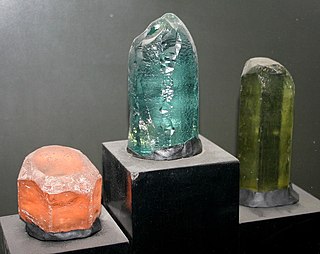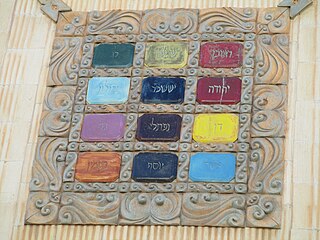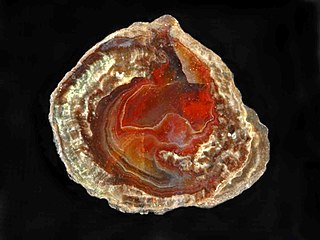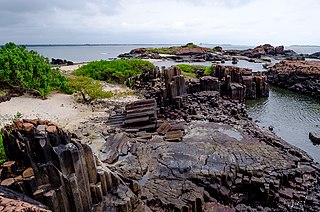
Agate is the banded variety of chalcedony, which comes in a wide variety of colors. Agates are primarily formed within volcanic and metamorphic rocks. The ornamental use of agate was common in Ancient Greece, in assorted jewelry and in the seal stones of Greek warriors, while bead necklaces with pierced and polished agate date back to the 3rd millennium BCE in the Indus Valley civilisation.

Beryl ( BERR-əl) is a mineral composed of beryllium aluminium silicate with the chemical formula Be3Al2Si6O18. Well-known varieties of beryl include emerald and aquamarine. Naturally occurring hexagonal crystals of beryl can be up to several meters in size, but terminated crystals are relatively rare. Pure beryl is colorless, but it is frequently tinted by impurities; possible colors are green, blue, yellow, pink, and red (the rarest). It is an ore source of beryllium.

Chalcedony ( kal-SED-ə-nee, or KAL-sə-doh-nee) is a cryptocrystalline form of silica, composed of very fine intergrowths of quartz and moganite. These are both silica minerals, but they differ in that quartz has a trigonal crystal structure, while moganite is monoclinic. Chalcedony's standard chemical structure (based on the chemical structure of quartz) is SiO2 (silicon dioxide).

Rhyolite is the most silica-rich of volcanic rocks. It is generally glassy or fine-grained (aphanitic) in texture, but may be porphyritic, containing larger mineral crystals (phenocrysts) in an otherwise fine-grained groundmass. The mineral assemblage is predominantly quartz, sanidine, and plagioclase. It is the extrusive equivalent of granite.

Jasper, an aggregate of microgranular quartz and/or cryptocrystalline chalcedony and other mineral phases, is an opaque, impure variety of silica, usually red, yellow, brown or green in color; and rarely blue. The common red color is due to iron(III) inclusions. Jasper breaks with a smooth surface and is used for ornamentation or as a gemstone. It can be highly polished and is used for items such as vases, seals, and snuff boxes. The density of jasper is typically 2.5 to 2.9 g/cm3. Jaspillite is a banded-iron-formation rock that often has distinctive bands of jasper.

Morgan Hill is a city in Santa Clara County, California, at the southern tip of Silicon Valley in the San Francisco Bay Area. Morgan Hill is an affluent residential community, the seat of several high-tech companies, and a dining, entertainment, and recreational destination, owing to its luxury hospitality, wineries, and nature parks.

Onyx is the parallel-banded variety of chalcedony, a silicate mineral. Agate and onyx are both varieties of layered chalcedony that differ only in the form of the bands; agate has curved bands while onyx has parallel bands. The colors of its bands range from black to almost every color. Specimens of onyx commonly contain bands of black and/or white. Onyx, as a descriptive term, has also been applied to parallel-banded varieties of alabaster, marble, calcite, obsidian, and opal, and misleadingly to materials with contorted banding, such as "cave onyx" and "Mexican onyx".

A marble is a small spherical object often made from glass, clay, steel, plastic, or agate. They vary in size, and most commonly are about 13 mm in diameter. These toys can be used for a variety of games called marbles, as well being placed in marble runs or races, or created as a form of art. They are often collected, both for nostalgia and for their aesthetic colors.

Agate Fossil Beds National Monument is a U.S. National Monument near Harrison, Nebraska. The main features of the monument are a valley of the Niobrara River and the fossils found on Carnegie Hill and University Hill.

Rhyolite is a ghost town in Nye County, in the U.S. state of Nevada. It is in the Bullfrog Hills, about 120 miles (190 km) northwest of Las Vegas, near the eastern boundary of Death Valley National Park.

The priestly breastplate or breastpiece of judgment was a sacred breastplate worn by the High Priest of the Israelites, according to the Book of Exodus. In the biblical account, the breastplate is termed the breastplate of judgment, because the Urim and Thummim were placed upon it. These elements of the breastplate are said in the Exodus verse to carry the judgement of God concerning the Israelites at all times.

A thunderegg is a nodule-like rock, similar to a filled geode, that is formed within rhyolitic volcanic ash layers. Thundereggs are rough spheres, most about the size of a baseball—though they can range from a little more than a centimeter to over a meter across. They usually contain centres of chalcedony which may have been fractured followed by deposition of agate, jasper or opal, either uniquely or in combination. Also frequently encountered are quartz and gypsum crystals, as well as various other mineral growths and inclusions. Thundereggs usually look like ordinary rocks on the outside, but slicing them in half and polishing them may reveal intricate patterns and colours. A characteristic feature of thundereggs is that the individual beds they come from can vary in appearance, though they can maintain a certain specific identity within them.

A dzi bead a type of agate bead of uncertain origin found in the Himalayan regions including Tibet, Bhutan, and Ladakh.

A lithophysa is a felsic volcanic rock with a spherulitic structure and interior cavity with concentric chambers. Its outer shape is spherical or lenticular. They vary in size from very small up to twelve feet in diameter depending on the age of the magma chamber. These rocks are usually found within obsidian or rhyolite lava flows. Lavas low in feldspar minerals may produce a version known as snowflake obsidian.

A volcanic belt is a large volcanically active region. Other terms are used for smaller areas of activity, such as volcanic fields or volcanic systems. Volcanic belts are found above zones of unusually high temperature where magma is created by partial melting of solid material in the Earth's crust and upper mantle. These areas usually form along tectonic plate boundaries at depths of 10 to 50 kilometres. For example, volcanoes in Mexico and western North America are mostly in volcanic belts, such as the Trans-Mexican Volcanic Belt that extends 900 kilometres (560 mi) from west to east across central-southern Mexico and the Northern Cordilleran Volcanic Province in western Canada. In the case of Iceland, the geologist G.G. Bárdarson in 1929 identified clusters of volcanic belts while studying the Reykjanes Peninsula.

St. Mary's Islands, also known as Coconut Island and Thonsepar, are a set of four small islands in the Arabian Sea off the coast of Malpe in Udipi, Karnataka, India. They are known for their distinctive geological formation of columnar rhyolitic lava (pictured).

Varieties of the color red may differ in hue, chroma or lightness, or in two or three of these qualities. Variations in value are also called tints and shades, a tint being a red or other hue mixed with white, a shade being mixed with black. A large selection of these various colors are shown below.
Morgan Advanced Materials plc is a company which manufactures specialist products, using carbon, advanced ceramics and composites. The group is headquartered in Windsor, United Kingdom, and has 70 sites across 18 countries. It is listed as public limited company on the London Stock Exchange and is a component of the FTSE 250 Index.

The Mount Jasper Lithic Source is a prehistoric archaeological site in Berlin, New Hampshire. Located on the slopes of Mount Jasper on the north side of the city, it includes one of the only known evidences of mining by pre-Contact Native Americans in the eastern United States. The mountain is a source of rhyolite, apparently prized for its qualities in the manufacture of stone tools. The site includes a mine shaft about 9 metres (30 ft) deep, as well as workshops at the base and summit of the mountain. The site was added to the National Register of Historic Places in 1992.

The Fairburn Agate is a type of gemstone found in the agate beds of Southwestern South Dakota and Northwestern Nebraska. It is also the state gemstone of South Dakota. Fairburns are characterized from other types of agate by their colors and the shape of the bands.




















